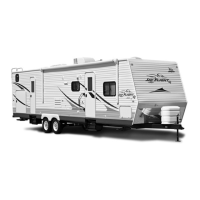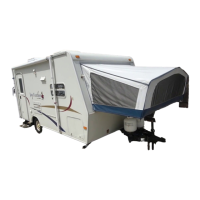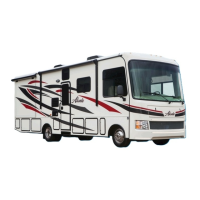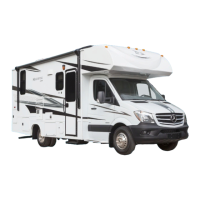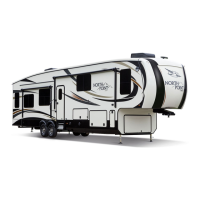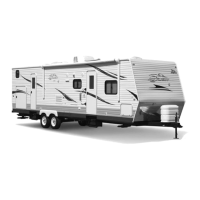Auxiliary Battery (Customer Supplied)
Your recreation vehicle has many 12-volt DC loads. When combined, their total is more
than the converter can produce. High demands for 12-volt power can be met by an
auxiliary battery for limited periods of time. The 12-volt DC electrical system is designed
for usage with a Group 27, deep cycle battery.
Dry camping
Consider the charge condition of the auxiliary battery when dry camping. If the auxiliary
battery is not being recharged and power is being drawn from it, it will eventually
discharge. A battery will discharge at a faster rate as its energy level becomes depleted. It
is recommended you plan your electrical usage accordingly. For accuracy, test the
auxiliary battery voltage using a volt-ohm meter (customer supplied).
A fully charged auxiliary battery will read 12.7 volts DC and 1.265 specific gravity at
80°F (32°C). The auxiliary battery is considered discharged at 11.8 volts, and dead at
11.65 volts.
When voltage drops below those levels, permanent damage may occur. Typically, a deep
cycle battery has an amp-hour rating of 75-100 amps.
If you run the furnace and refrigerator simultaneously, you will be using approximately
(12.0 + 3.0) 15.0 amps per hour. This does not include any 12-volt lights, water pump or
any other 12-volt component.
If the furnace and refrigerator in the above example operated constantly, a 75
amp-hour battery would become fully discharged in 5 hours (75ah / 15a = 5h).
The auxiliary battery should be installed in parallel with the battery in your tow vehicle.
When the 7-way trailer plug is connected, both batteries power the RV so it is important
not to discharge your tow vehicle battery below the level required to start the engine. To
prevent this from occurring, disconnect the 7-way trailer plug or install a battery isolator.
When the tow vehicle engine is operating with the RV connected, the tow vehicle charging
system will charge both batteries.
Replacement and maintenance
Some equipment in your RV will draw small amounts of current even when turned OFF.
To prevent the auxiliary battery from being discharged when your RV is not connected to
shore line power, disconnect the auxiliary battery negative cable at the battery. During
storage, it is important to check the voltage monthly and recharge the auxiliary battery as
needed. If you remove the auxiliary battery from your RV, store it in a dry, cool area per
the manufacturer’s instructions.
When it is time to replace the auxiliary battery, replace it with a Group 27 deep cycle
battery only. Contact the battery manufacturer for further information. Do not reverse the
positive and negative battery cables (doing so will blow the reverse polarity fuse(s) that
protect the converter).
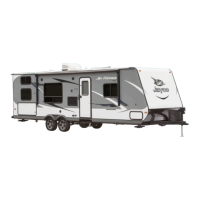
